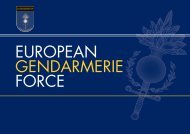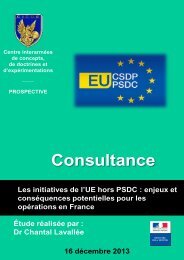Conference
science-research-bulletin-2013-conference
science-research-bulletin-2013-conference
You also want an ePaper? Increase the reach of your titles
YUMPU automatically turns print PDFs into web optimized ePapers that Google loves.
EUROPEAN POLICE SCIENCE AND RESEARCH BULLETIN<br />
SPECIAL CONFERENCE EDITION<br />
of reducing public spending) were ejected from<br />
a handful of stores and the branch of a wellknown<br />
High Street bank, and when a 24-year-old<br />
man ignited a firework flare and scaled a police<br />
protective barrier in what resulted in the only<br />
arrest of the entire event.<br />
It is indisputable that the presence of this<br />
barrier, which was integral to a part-metal, partconcrete<br />
‘fence’, encircling the City Hall venue,<br />
was fundamental to the success of the police<br />
operation, insofar as it helped limit direct contact<br />
between police and protesters, while still enabling<br />
the latter to remain within sight and sound of<br />
the arriving Lib Dem delegates. Arguably of even<br />
more significance, however, were the activities of<br />
the 15-person Police Liaison Team (PLT), which<br />
engaged in pre-event discussion and negotiation<br />
with protest organisers, and then mingled with<br />
the crowds on the two days of the event with the<br />
intentions of facilitating protest and promoting<br />
a ‘no surprises approach’ to the policing of the<br />
demonstration.<br />
THE POLICE LIAISON TEAM:<br />
ETHOS AND OBJECTIVES<br />
Previous publications (e.g. D. Waddington, 2011,<br />
2013) have emphasised that SYP’s decision to<br />
adopt a deliberately ‘facilitating’ police liaison<br />
approach to their handling of the anti-Lib Dem<br />
protest reflected an enduring force commitment<br />
to restoring public trust and confidence in the<br />
wake of the their controversial roles in the 1984-<br />
5 miners’ strike and the 1989 Hillsborough<br />
stadium disaster (see esp. D. Waddington [2011]<br />
for a fuller discussion of these cases). Interviewees<br />
also referred to the progressive and liberalminded<br />
attitudes of their more senior colleagues<br />
as another determinant of this novel strategic<br />
direction. Particular emphasis was placed on<br />
the fact that SYP’s Chief Constable currently<br />
occupied the position of ACPO (Association of<br />
Chief Police Officers) Lead on public order, and<br />
had recently signed off a document committing<br />
all British forces to a more communicationoriented<br />
approach (ACPO/ACPO/NPIA, 2010).<br />
‘I can’t speak about other areas, but I do think<br />
that, in this force we are very alive to and<br />
receptive to these types of ideas and relatively<br />
forward-thinking…and I do think that we’re<br />
extremely keen to embrace all of this stuff. I also<br />
think that [The Silver Commander’s] openness to<br />
looking at new ideas was also really encouraging<br />
from an operational and planning point of view’.<br />
(Interview, Public Order Bronze)<br />
One main objective of the police operation was<br />
to provide the Silver Commander with what<br />
he termed an ‘information picture’ of the likely<br />
size and composition of the crowd, of which<br />
constituent sections or individuals were liable to<br />
prove cooperative or not, and of what policing<br />
measures were therefore necessary to balance<br />
the right to protest with the corresponding need<br />
to maintain public order. A second important<br />
goal was to cultivate a ‘no surprises’ approach<br />
whereby the intentions and activities of all parties<br />
were as well communicated, predictable and<br />
mutually endorsed a possible. The final, arguably<br />
overriding, police objective was to enhance their<br />
capacity to make sensible, well-informed tactical<br />
interventions:<br />
‘The third bit for me was that I wanted the<br />
capability to build a dynamic risk assessment<br />
to assist actual decision-making — about the<br />
potential impact of police tactics, really, so we<br />
could have that discussion around ‘What’s the<br />
best approach, here, to deal with that element<br />
of the crowd, in your view from the vantage point<br />
of being down amongst the crowd?’ (Interview,<br />
Silver Commander)<br />
To accomplish these objectives, the Silver<br />
Commander set up a 15-person Police Liaison<br />
Team (PLT), to be centrally coordinated on the<br />
day of the event by a remote ‘Silver Command’<br />
team consisting of himself and an assistant<br />
Negotiator Co-ordinator, a female colleague of<br />
equal rank. This pair worked in close conjunction<br />
with a five-person Social Media Team (SMT),<br />
led by a female inspector, whose function was<br />
to monitor and respond to relevant messages<br />
appearing on Twitter, Facebook and the Sheffield<br />
Forum blog, and to transmit informative and<br />
reassuring messages to protesters and members<br />
of the wider general public.<br />
While immediate overall authority over the PLT<br />
was assigned to a Bronze commander at Chief<br />
Inspector level (the ‘PLT Bronze’), during the<br />
protest proper the team was divided up into equal<br />
sub-groups of five. The first of these consisted of<br />
four lower-ranking officers (sergeants or police<br />
constables) under the direct supervision of the<br />
PLT Bronze, and the remaining two of similar<br />
groups of junior officers which each reported to<br />
35





